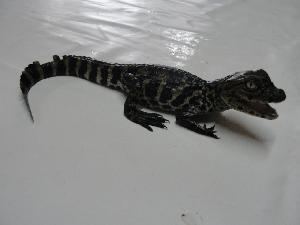Clade Jacarea Higher classification Alligators | Scientific name Caiman Rank Genus | |
 | ||
Lower classifications spectacled caiman, yacare caiman, Broad‑snouted caiman | ||
Caiman facts 20 facts about caimans
Caiman is a genus of caimans within the alligatorid subfamily Caimaninae. They inhabit Central and South America. They are relatively small sized crocodilians, with all species reaching lengths of only a few meters and weighing 6 to 40 kg (13 to 88 lb) on average.
Contents
- Caiman facts 20 facts about caimans
- Characteristics
- Distribution and habitat
- Behaviour
- Taxonomy
- References
Characteristics

Caimans are similar to alligators in morphology but differ in having bony plates, known as osteoderms, buried in the skin on the underside. The broad-snouted and spectacled caimans are characterised by having a bony ridge across the bridge of the nose just below the eyes. The Yacare caiman is the largest species in the genus, attaining an average adult length of 2.5 to 3 m (8.2 to 9.8 ft), the Spectacled caiman reaches 2 to 2.5 m (6.6 to 8.2 ft), with the female rather smaller, and the broad-snouted caiman is the smallest, more typically measuring 1.8 to 2 m (5.9 to 6.6 ft) for males and 1.2 to 1.4 m (3.9 to 4.6 ft) for females.
Distribution and habitat
This genus is present in Central and South America. The spectacled caiman (Caiman crocodilus) occurs in Central America and parts of the northern half of South America at altitudes of up to about 800 m (2,600 ft). It is usually found in freshwater, but also visits the brackish water of estuaries on occasion. It has varying habitats including wetlands and slow-moving rivers and streams. The yacare caiman (Caiman yacare) occurs in the central part of southern South America, particularly in the Pantanal region, the largest tropical wetland area in the world, which is flooded seasonally by the Paraguay River. The Broad-snouted caiman (Caiman latirostris) occurs in central and eastern South America, its range including southeastern Brazil, Bolivia, Paraguay, Uruguay and northern Argentina, within the drainage systems of the Paraná, Paraguay, Uruguay and São Francisco Rivers.
Behaviour
Caimans spends much of their time basking on mudflats or in sunlit, muddy jungle streams. In the dry season, large numbers may accumulate in pools as the surrounding land dries up. They can move on land with some rapidity, hiss when disturbed, and young individuals can inflate themselves before opening their jaws aggressively. Caimans do not usually attack humans but domestic livestock are at risk. They seize their prey and drag it underwater to drown it. They may observe a potential prey, swim away, submerge and return to attack the floating bird or drinking mammal from underwater. Juvenile caimans feed on crustaceans and molluscs while larger animals feed on amphibians, fish, birds, mammals and reptiles.
A caiman nest is a mound of vegetation and mud consolidated by the female by lying on it. She then digs a hole in it and buries a few dozen eggs in it. When these hatch, the juveniles use their egg teeth to break their way out. They are about 23 cm (9 in) long at hatching, growing to 60 cm (24 in) by a year later. They look like miniature versions of their parents but have relatively shorter snouts and larger eyes.
